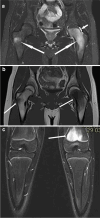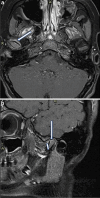A clinical perspective on imaging in juvenile idiopathic arthritis
- PMID: 38015293
- PMCID: PMC10984900
- DOI: 10.1007/s00247-023-05815-2
A clinical perspective on imaging in juvenile idiopathic arthritis
Abstract
In recent years, imaging has become increasingly important to confirm diagnosis, monitor disease activity, and predict disease course and outcome in children with juvenile idiopathic arthritis (JIA). Over the past few decades, great efforts have been made to improve the quality of diagnostic imaging and to reach a consensus on which methods and scoring systems to use. However, there are still some critical issues, and the diagnosis, course, and management of JIA are closely related to clinical assessment. This review discusses the main indications for conventional radiography (XR), musculoskeletal ultrasound (US), and magnetic resonance imaging (MRI), while trying to maintain a clinical perspective. The diagnostic-therapeutic timing at which one or the other method should be used, depending on the disease/patient phenotype, will be assessed, considering the main advantages and disadvantages of each imaging modality according to the currently available literature. Some brief clinical case scenarios on the most frequently and severely involved joints in JIA are also presented.
Keywords: Children; Conventional radiography; Imaging; Juvenile idiopathic arthritis; Magnetic resonance imaging; Ultrasound.
© 2023. The Author(s).
Conflict of interest statement
None
Figures









Similar articles
-
Imaging assessment of children presenting with suspected or known juvenile idiopathic arthritis: ESSR-ESPR points to consider.Eur Radiol. 2020 Oct;30(10):5237-5249. doi: 10.1007/s00330-020-06807-8. Epub 2020 May 12. Eur Radiol. 2020. PMID: 32399709 Free PMC article. Review.
-
Juvenile idiopathic arthritis - the role of imaging from a rheumatologist's perspective.Pediatr Radiol. 2018 Jun;48(6):785-791. doi: 10.1007/s00247-017-4014-7. Epub 2018 May 8. Pediatr Radiol. 2018. PMID: 29766250 Review.
-
Imaging of Juvenile Idiopathic Arthritis.Radiol Clin North Am. 2024 Sep;62(5):889-902. doi: 10.1016/j.rcl.2024.02.009. Epub 2024 Mar 22. Radiol Clin North Am. 2024. PMID: 39059979 Review.
-
Imaging in Juvenile Idiopathic Arthritis.Rheum Dis Clin North Am. 2024 Nov;50(4):623-640. doi: 10.1016/j.rdc.2024.07.004. Epub 2024 Aug 24. Rheum Dis Clin North Am. 2024. PMID: 39415371 Review.
-
Current Status of Efforts on Standardizing Magnetic Resonance Imaging of Juvenile Idiopathic Arthritis: Report from the OMERACT MRI in JIA Working Group and Health-e-Child.J Rheumatol. 2016 Jan;43(1):239-44. doi: 10.3899/jrheum.141276. Epub 2015 May 15. J Rheumatol. 2016. PMID: 25979714 Review.
Cited by
-
ESPR 2023-Building new bridges from Belgrade.Pediatr Radiol. 2024 Apr;54(4):479-480. doi: 10.1007/s00247-024-05866-z. Pediatr Radiol. 2024. PMID: 38300285 No abstract available.
-
Imaging evaluation of rheumatologic musculoskeletal disorders in children.Skeletal Radiol. 2025 Mar 29. doi: 10.1007/s00256-025-04910-9. Online ahead of print. Skeletal Radiol. 2025. PMID: 40156723 Review.
-
A narrative review of multidisciplinary rehabilitation in juvenile idiopathic arthritis.Clin Rheumatol. 2025 May;44(5):1887-1897. doi: 10.1007/s10067-025-07407-x. Epub 2025 Mar 25. Clin Rheumatol. 2025. PMID: 40131596 Review.
References
-
- Thierry S, Fautrel B, Lemelle I, Guillemin F. Prevalence and incidence of juvenile idiopathic arthritis: a systematic review. Joint Bone Spine. 2014;81:112–117. - PubMed
-
- Brewer EJ, Jr, Bass J, Baum J, et al. Current proposed revision of JRA Criteria. JRA Criteria Subcommittee of the Diagnostic and Therapeutic Criteria Committee of the American Rheumatism Section of The Arthritis Foundation. Arthritis Rheum. 1977;20:195–199. - PubMed
-
- Malattia C, Tzaribachev N, van den Berg JM, Magni-Manzoni S. Juvenile idiopathic arthritis - the role of imaging from a rheumatologist’s perspective. Pediatr Radiol. 2018;48:785–791. - PubMed
Publication types
MeSH terms
Grants and funding
LinkOut - more resources
Full Text Sources
Medical
Miscellaneous

